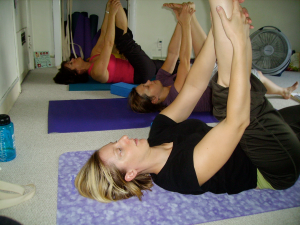 We are offering key insight about Yin Yoga in a wonderful book review written by one of Clayton Yoga’s Teacher Training students, Christina Binkley.
We are offering key insight about Yin Yoga in a wonderful book review written by one of Clayton Yoga’s Teacher Training students, Christina Binkley.
This book is “an innovative synthesis of traditional yoga, meditation, and Eastern approaches to healing and well-being”. While covering topics such as meridian theory, Yin and Yang yoga practice, and sharing some of her own personal journey, Sarah Powers maintains a judgement free and caring attitude while helping the reader to bring himself/herself inward, aiding the reader with cultivating a lasting relationship with yoga.
The meridians (Chinese system) as the author explains are energy flows throughout the body. Somewhat like rivers, these pathways of energy flow through all tissues and bones, moistening the joints and connecting he interior tissues. She insists thatn in order for good health, it is essential for meridians to open, flow, and move freely throughout the body. Many masters support this meridian theory and they as Sarah Powers, suggest that by influencing the connective tissue, we can positively effect the flow of the meridians.
The Chi, or energy flowing through the meridians has two aspects. The yin and yang are oppostional plarities. They are of the same essence but reflect different qualities and so they are inseparable. we can influence yin and yang of the body through movements in yoga. First, we must understand which are the yin and which are the yang.
Yang refer to the warm, the pliant, the superficial, the masculine, and closer to the heavens. We can also say that within the body, the yang refers to the muscles, skin and fascia.
Conversely, yin refers to cooler, less mobile, more hidden, feminine and closer to the earth. Therefore we can use yin to describe the bones, ligaments, tendons and other connective tissues. So a Yang practice would be more a Hatha, Ashtanga, or Vinyasa session. Whereas a Yin practice would be a session where poses are held for longer periods of time, two to five minutes is usual.
Yang practices resembles physical therapy, so says the author, where yin tissues require slow gradual pulling and compression because they do not have the same elasticity and less fluid as the yang tissues. When we do a yin practice, we are essentially doing the same, or similar poses, just in a yin way. Instead of coming into a pose for a short time and hugging the bones close together; we pull part the skeleton nonagressively with appropriate pressure and remain for awhile. This longer holding of poses encourages blood to flow into the joints allowing more chi and healing. Yin practices resenble the healing modality of traction. These five minute holds are not meant to stretch an area, but are meant to be placed under tencile pressure, thereby triggering the body’s natural healng response to stress by circulating chi throughout the body.
Sarah Powers believe, as do also her mentors, with with consistent practice, one can maintain elasticity in our joints for as long as we live. On the partner dvd, also entitled Insight Yoga, there are many sequences offered for both Yin and Yang practices. To anyone interested in learning more about Yin Yoga, and the benefits and challenges thereof, I would suggest both the book and the dvd. I thoroughly enjoy Sarah’s calm voice and way of informating the listener of the poses how to get into and out of the poses as well as what to look out for when releasing the pose. Both the book and the dvd are beautiful ways to introduce yourself to the concept of Yin Yoga.
Would you like to get more details on getting yoga classes started at your company or practicing at Clayton Yoga, please feel free to contact us through our Contact page.
